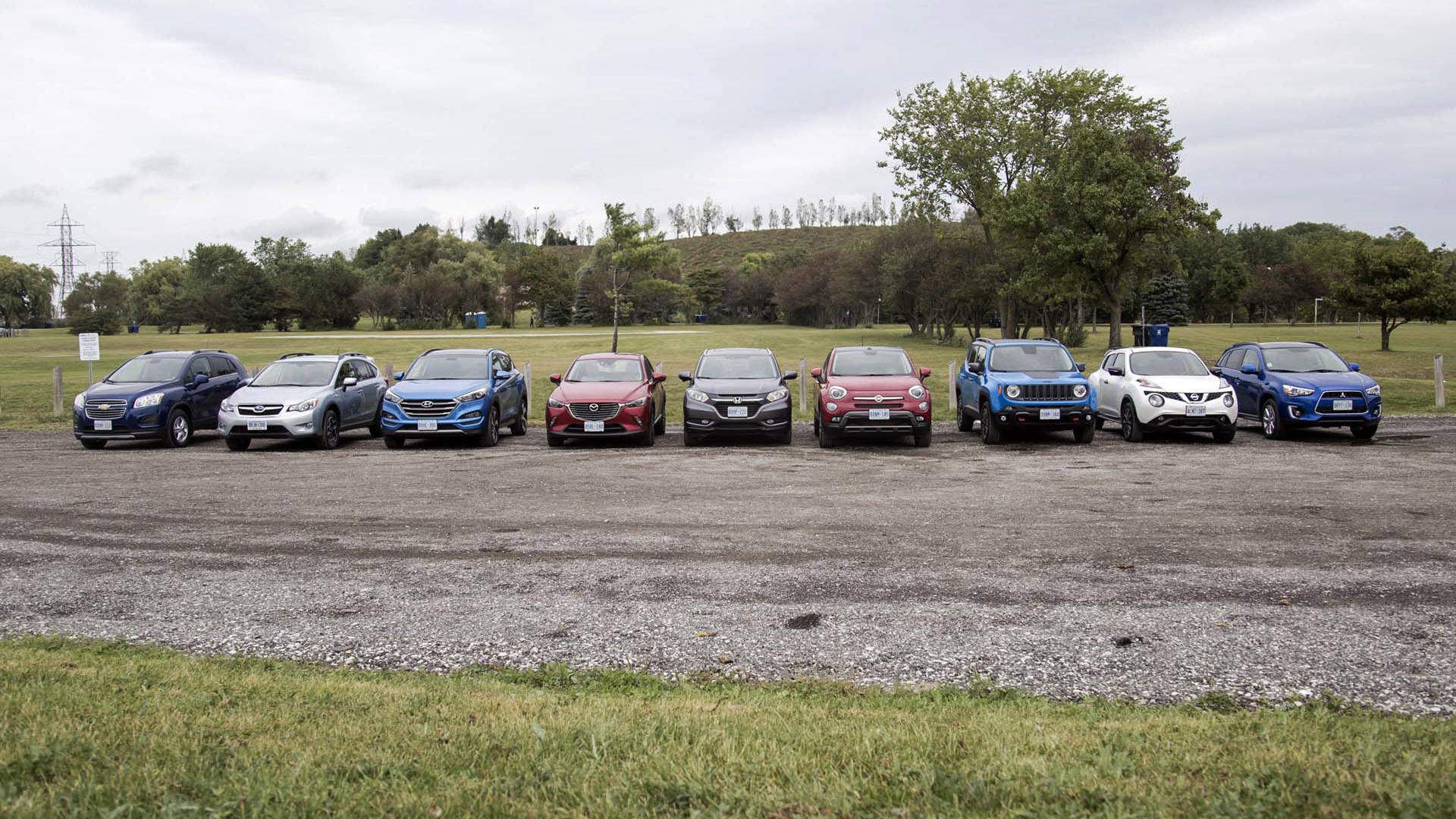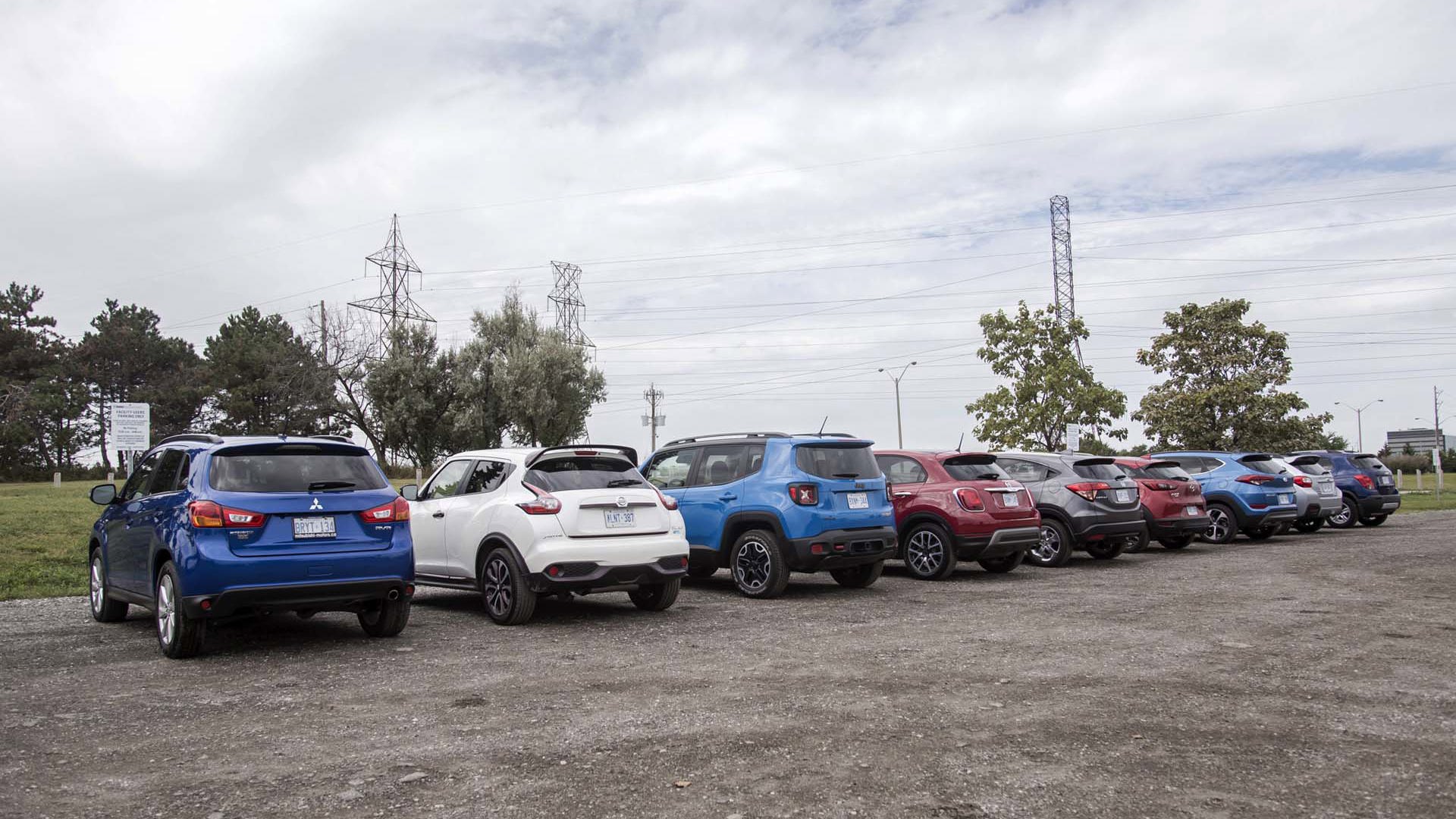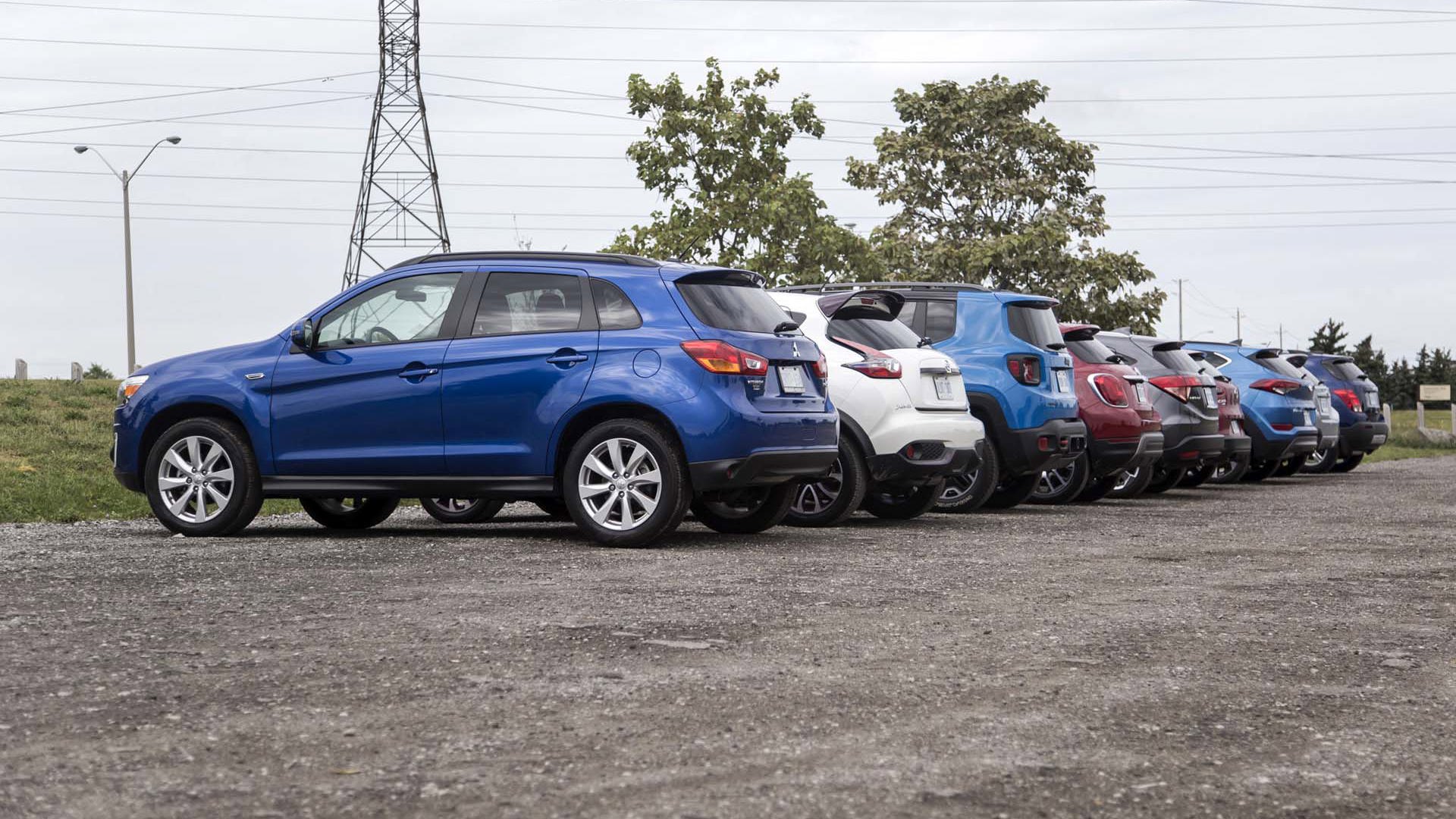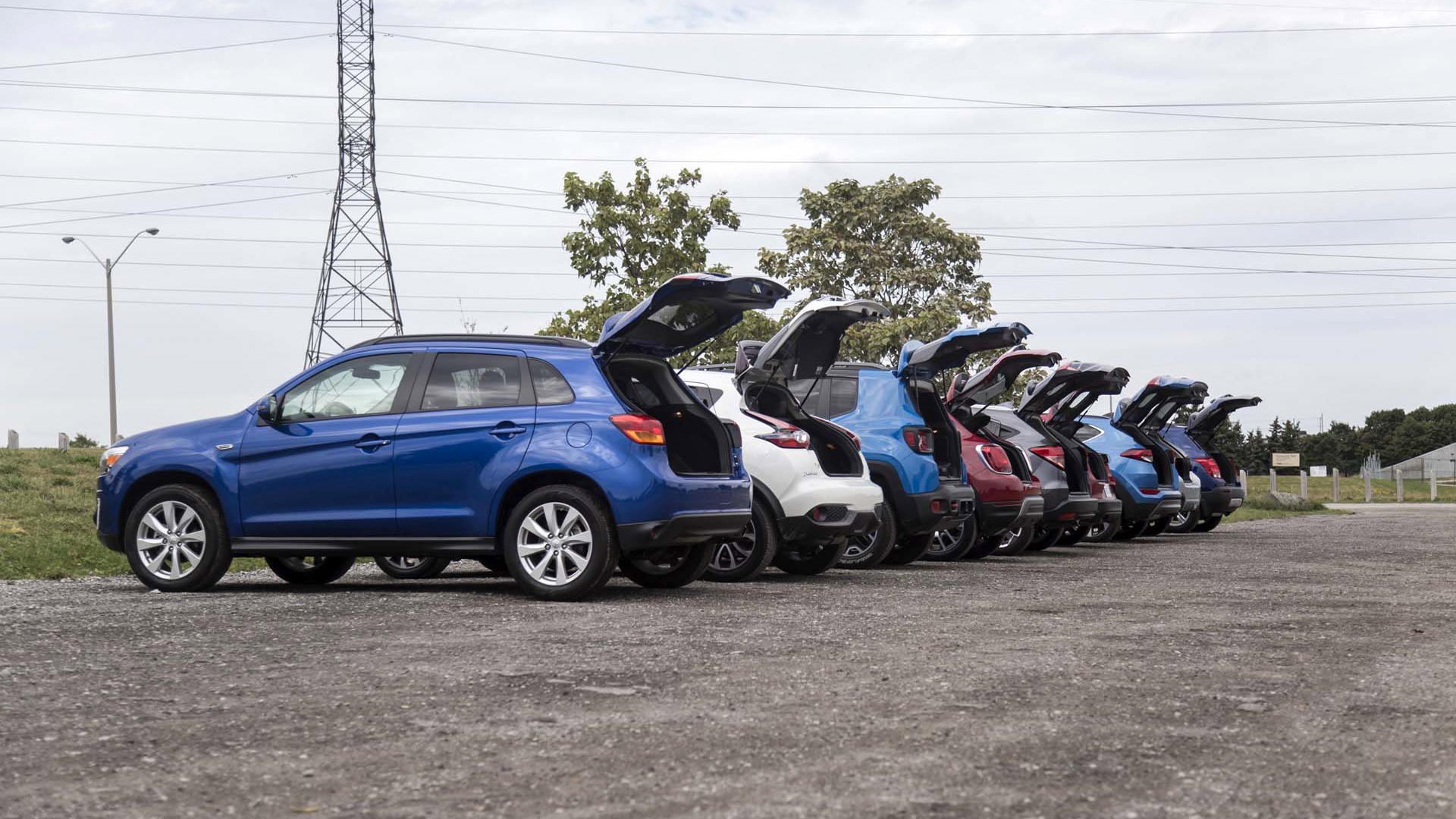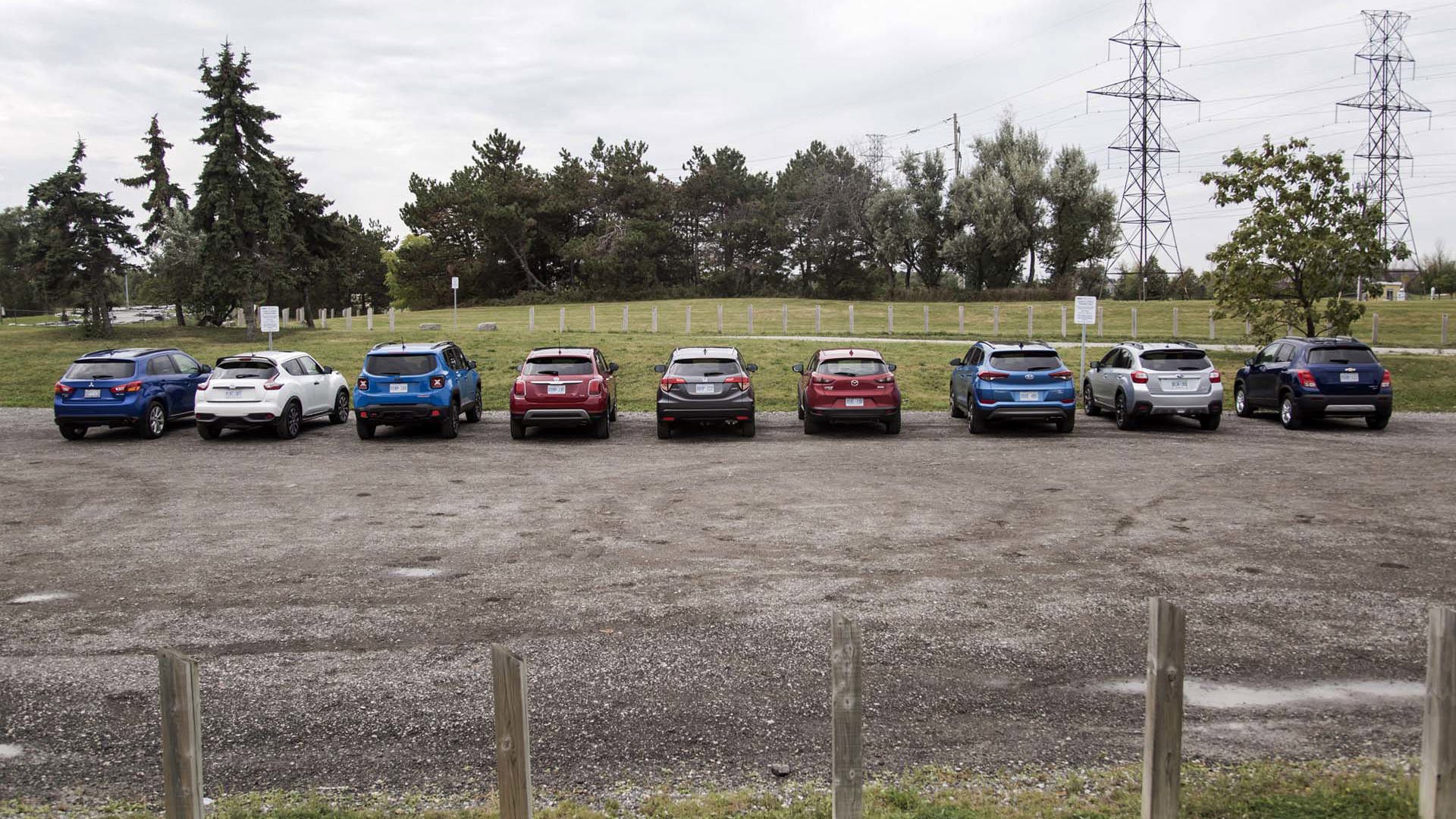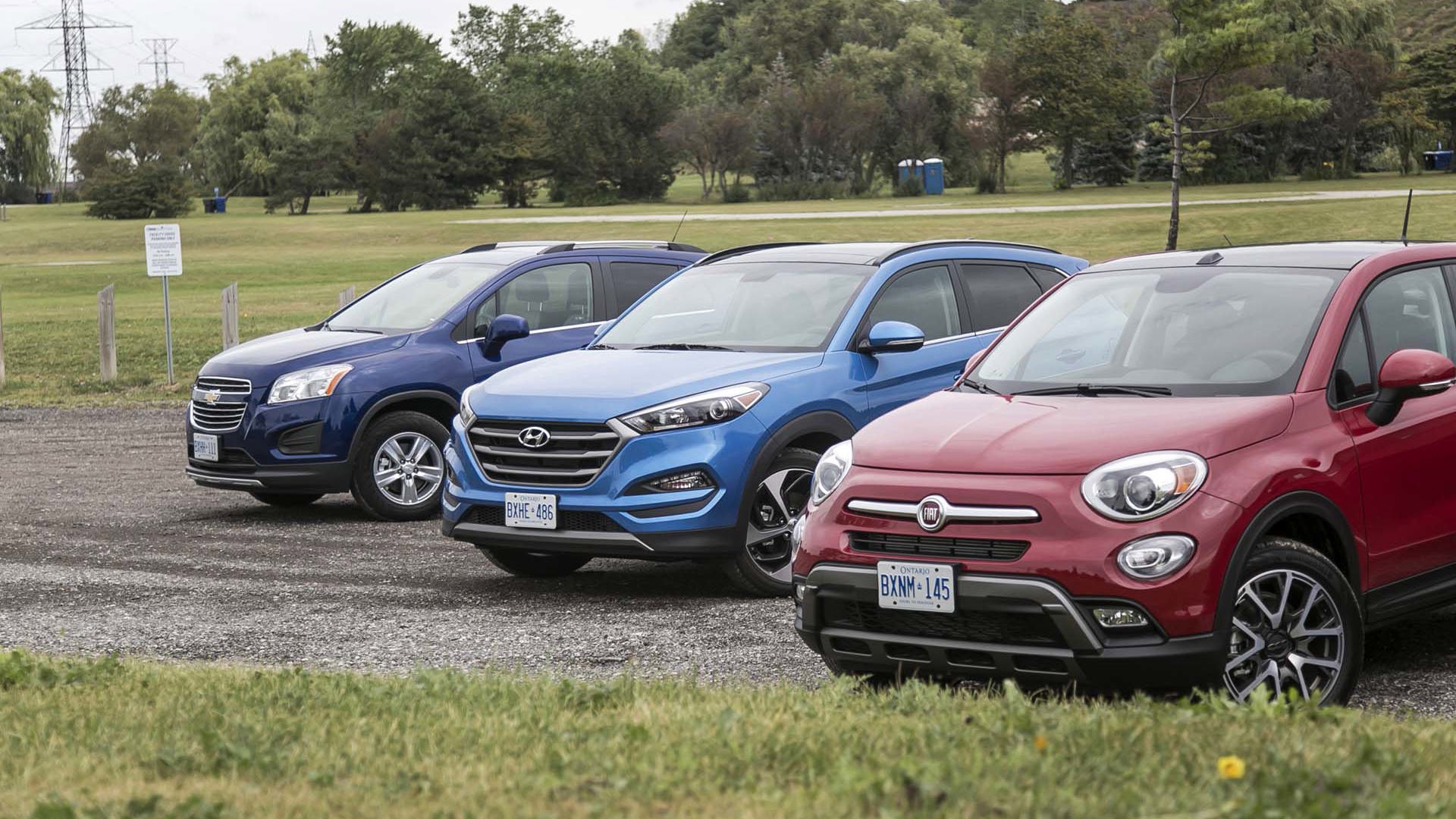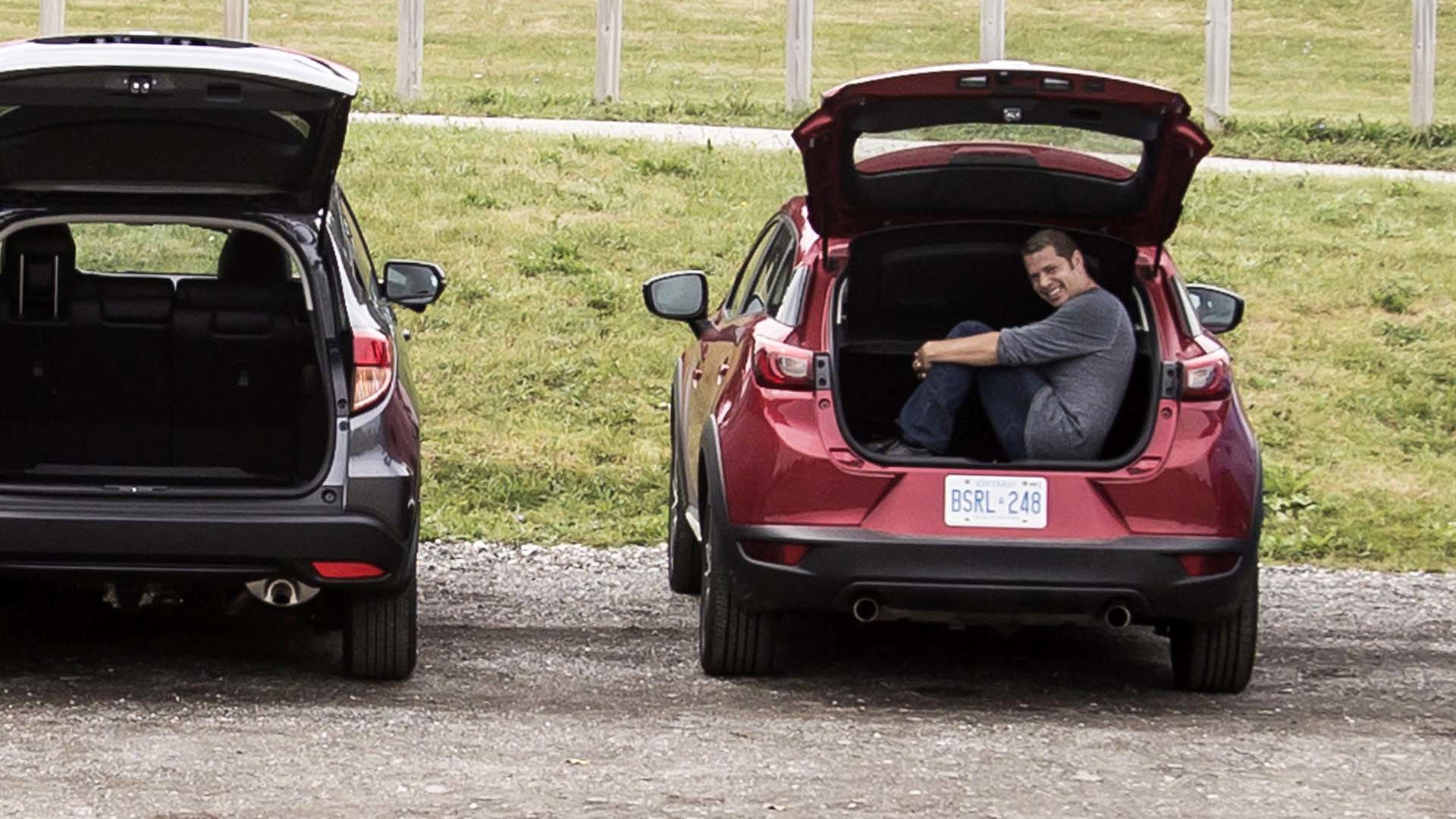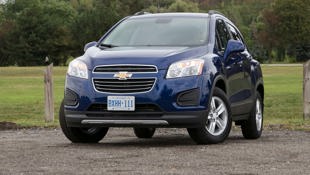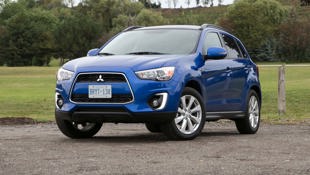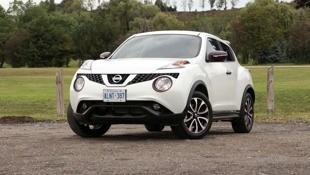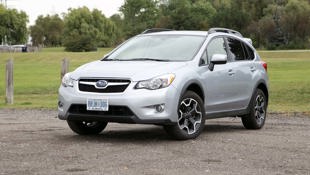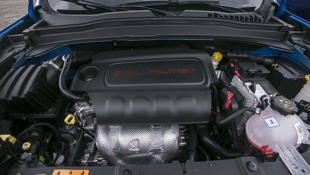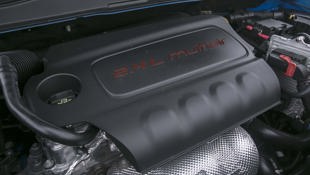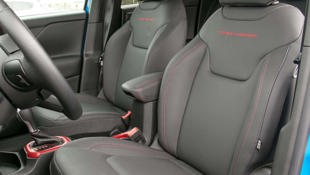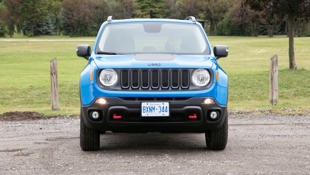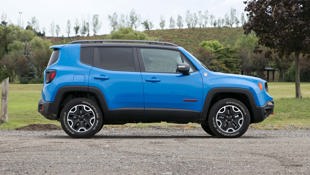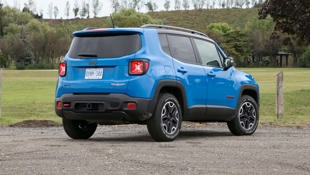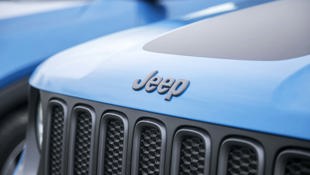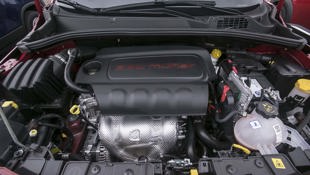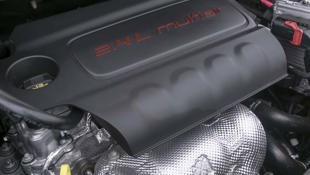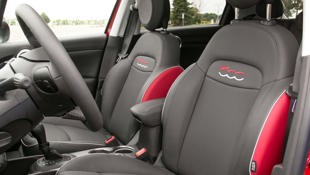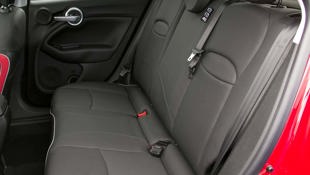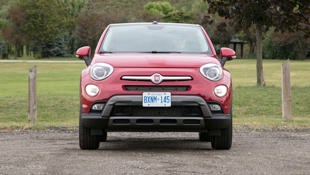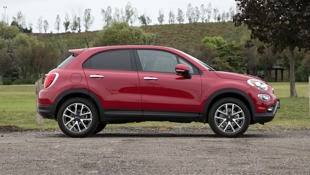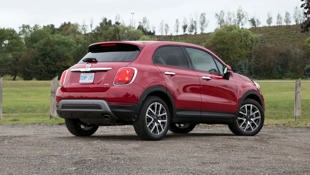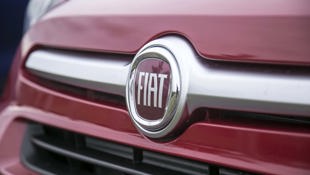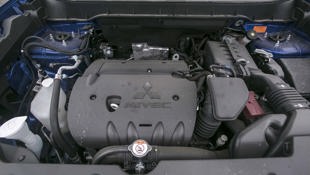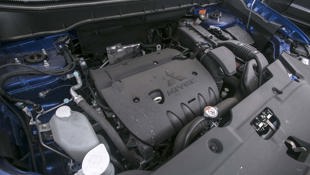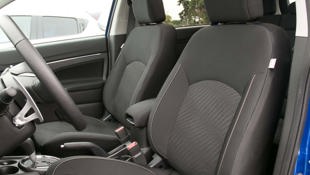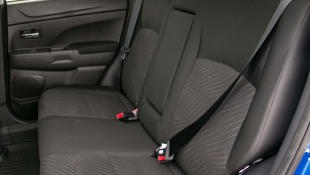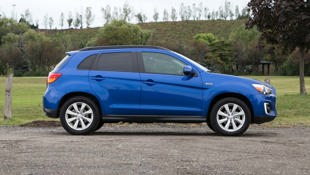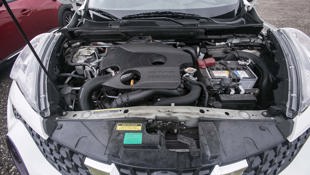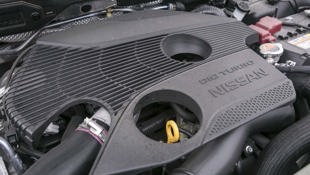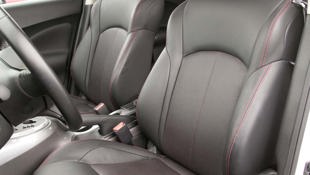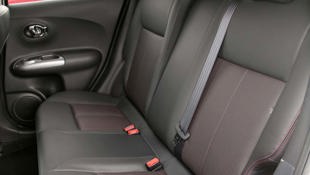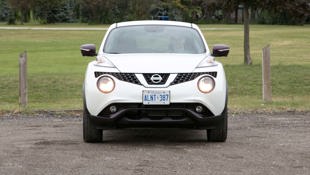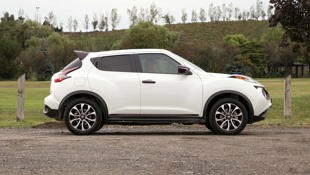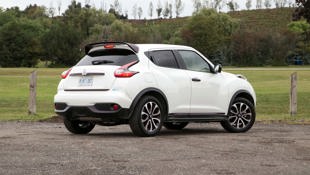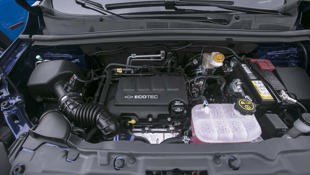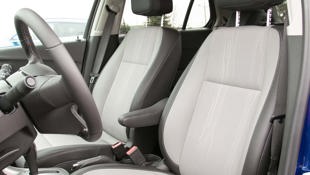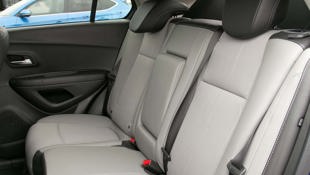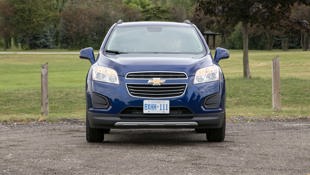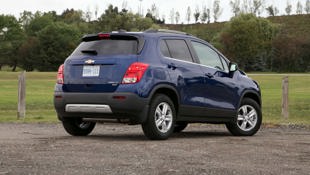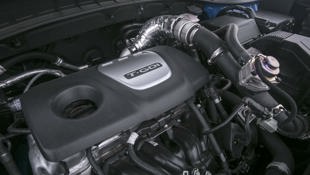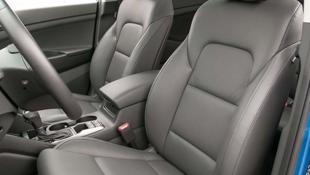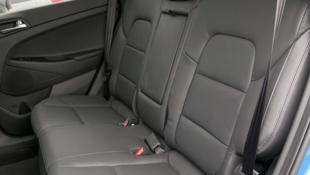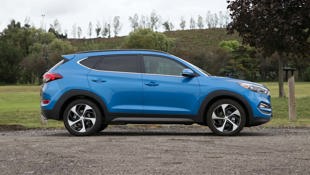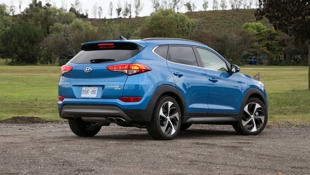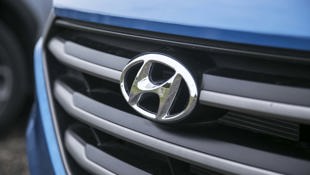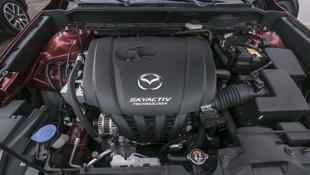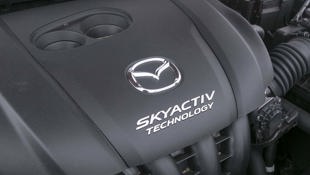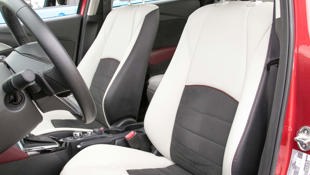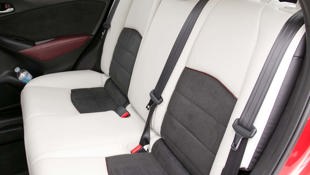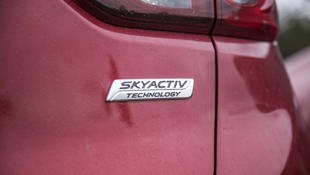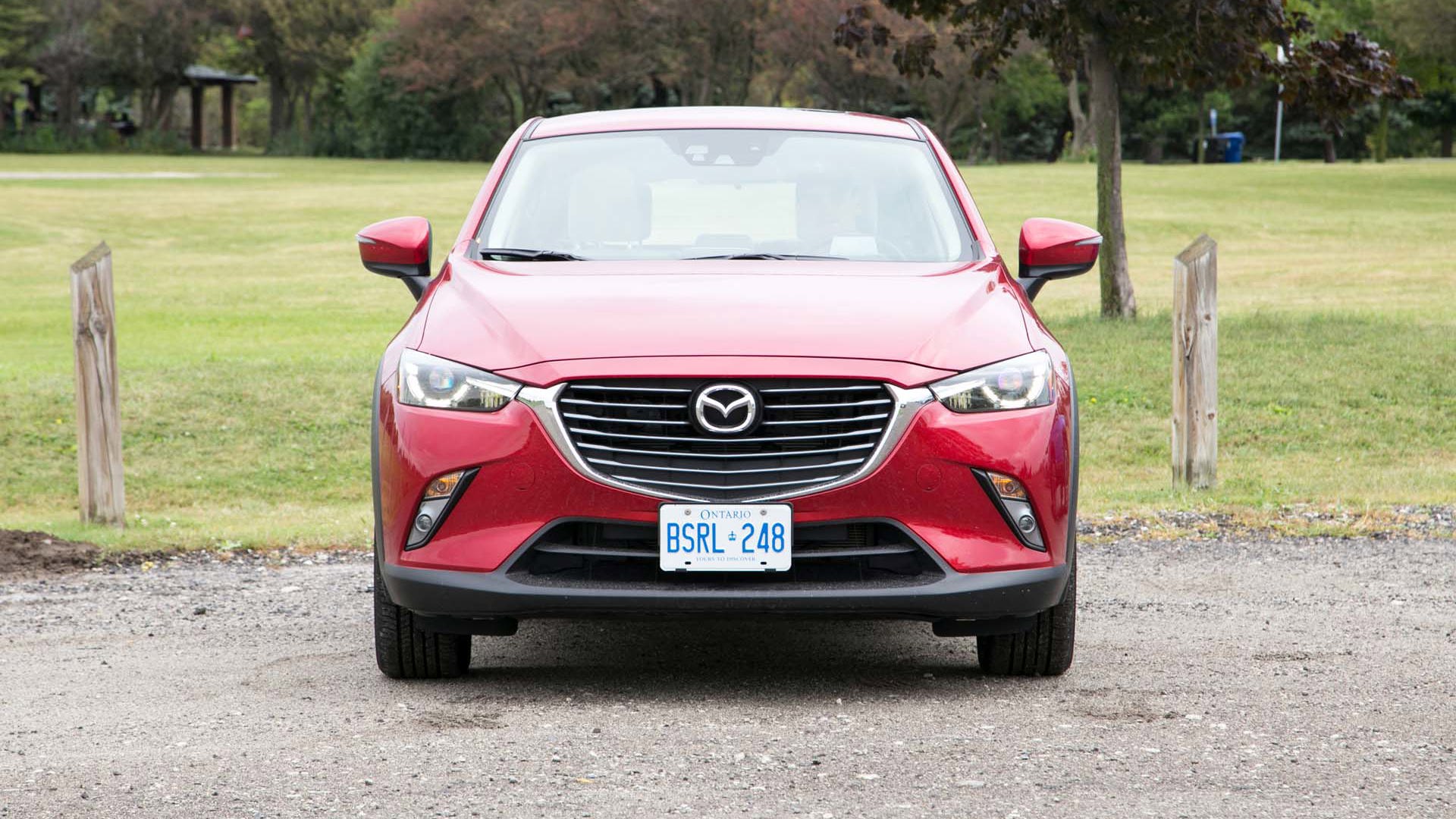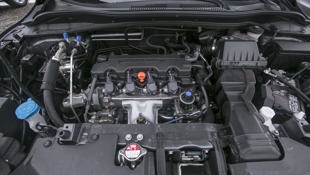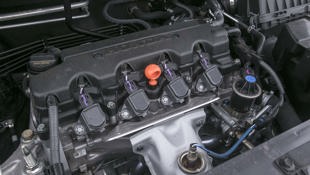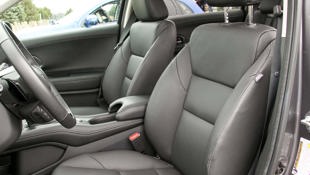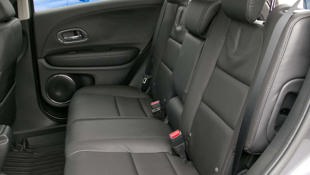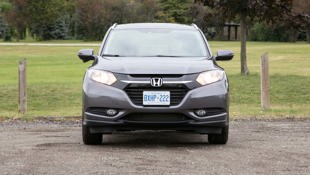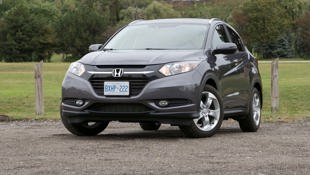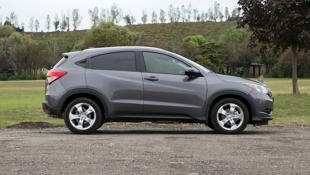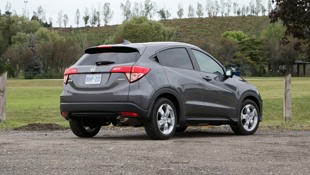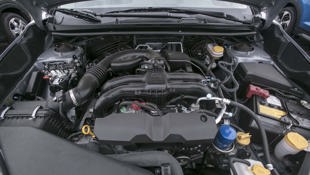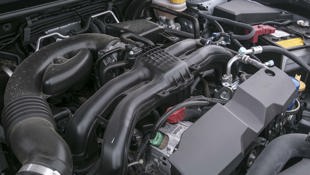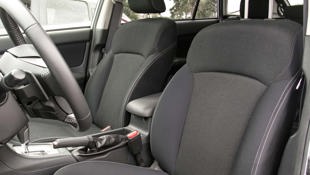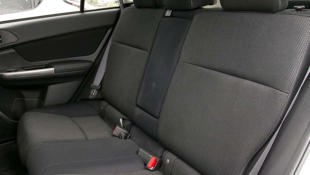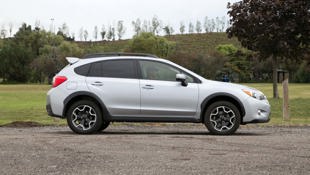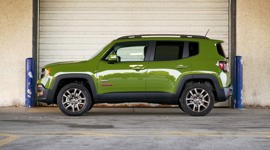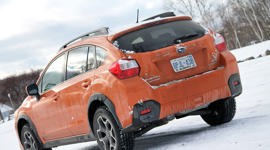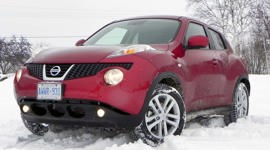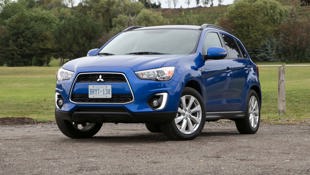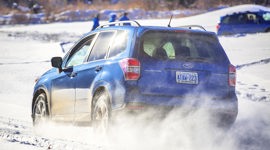Comparison Data
|
2015 Chevrolet Trax
|
2016 Fiat 500X
|
2016 Honda HR-V
|
2016 Hyundai Tucson
|
2015 Jeep Renegade
|
2016 Mazda CX-3
|
2015 Mitsubishi RVR
|
2015 Nissan Juke
|
2015 Subaru XV Crosstrek
|
|---|---|---|---|---|---|---|---|---|
|
Engine Displacement
1.4L
|
2.4L
|
1.8L
|
1.6L
|
2.4L
|
2.0L
|
2.4L
|
1.6L
|
2.0L
|
|
Engine Cylinders
I4
|
I4
|
I4
|
I4
|
I4
|
I4
|
I4
|
I4
|
H4
|
|
Peak Horsepower
138 hp
|
180 hp
|
141 hp
|
175 hp
|
180 hp
|
146 hp
|
168 hp
|
188 hp
|
148 hp
|
|
Peak Torque
148 lb-ft
|
175 lb-ft
|
127 lb-ft
|
195 lb-ft
|
175 lb-ft
|
146 lb-ft
|
167 lb-ft
|
177 lb-ft
|
145 lb-ft
|
|
Fuel Economy
9.7 / 7.6 / 8.7 L/100 km cty/hwy/cmb
|
11.0 / 7.9 / 9.6 L/100 km cty/hwy/cmb
|
8.8 / 7.2 / 8.1 L/100 km cty/hwy/cmb
|
9.9 / 8.4 / 9.2 L/100 km cty/hwy/cmb
|
11.2 / 8.0 / 9.8 L/100 km cty/hwy/cmb
|
8.8 / 7.3 / 8.1 L/100 km cty/hwy/cmb
|
10.4 / 8.5 / 9.6 L/100 km cty/hwy/cmb
|
8.8 / 7.5 / 8.2 L/100 km cty/hwy/cmb
|
9.1 / 7.0 / 8.1 L/100 km cty/hwy/cmb
|
|
Cargo Space
530 / 1,371 L
|
399 / 1,127 L
|
657 / 1,583 L
|
878 / 1,753 L
|
524 / 1,441 L
|
408 / 1,484 L
|
569 / 1,382 L
|
297 / 1,017 L
|
631 / 1,470 L
|
|
Base Price
$27,460
|
$32,690
|
$29,990
|
$36,649
|
$30,995
|
$28,995
|
$29,398
|
$30,178
|
$29,495
|
|
A/C Tax
$100
|
$100
|
$100
|
$100
|
$100
|
$100
|
$100
|
$100
|
$100
|
|
Destination Fee
$1,700
|
$1,745
|
$1,695
|
$1,795
|
$995
|
$1,895
|
$1,700
|
$1,695
|
$1,650
|
|
Price as Tested
$31,575
|
$37,720
|
$31,785
|
$38,544
|
$38,825
|
$32,490
|
$31,198
|
$32,273
|
$31,245
|
|
Optional Equipment
$2,315 – Sun and Sound, $1,100; LT Plus Package, $840: Splash guards, $190; All-weather floor mats, $185
|
$3,185 – Navigation Group, $1,100; Beats Audio, $495; Power sunroof, $1,295; Compact spare tire, $295
|
None
|
None
|
$6,735 – Trail Tow Group, $350; Premium Leather Group, $1,895; Premium Navigation Group, $1,100; Safety & Security Group, $795; “My Sky” power/removable roof system, $1,595; Black Hood Decal, $150; 9-speaker system w/ subwoofer, $400; back-up camera, $450
|
$1,500 – Technology Package, $1,500
|
None
|
$300 – Pearl White paint, $300
|
None
|
Chevrolet Trax vs Fiat 500X vs Honda HR-V vs Hyundai Tucson vs Jeep Renegade vs Mazda CX-3 vs Mitsubishi RVR vs Nissan Juke vs Subaru XV Crosstrek
Review by Jacob Black, Peter Bleakney, Ronnie Fung, Lesley Wimbush, Jeff Wilson, Jonathan Yarkony
Photos by Ronnie Fung and Jeff Wilson
Introduction, Jacob Black
We’ve got them all here with only two exceptions.
Everything in the automotive kingdom these days is getting bigger it seems. Cars and SUVs especially are growing, expanding and bloating like so many Christmas revelers. The bloat has become so substantial that an entire new size category has opened up at the bottom: one for subcompact SUVs and crossovers.
In the last 12 months the segment has doubled in size; where before there were five or six that could be classed within, now there are ten.
The divisive but fun-to-drive Nissan Juke was arguably the first true subcompact SUV blazing a trail here in Canada, with the popular Mitsubishi RVR and often underestimated Chevrolet Trax and its Buick Encore twin joining the fray. And then along came the Subaru XV Crosstrek – which is a tall wagon, but it’s quite tall and comes to the party with Subaru’s vaunted AWD system.
Yet this quartet played in pretty much its own niche for the last few years – with the Mini Countryman also part of the party depending on who you spoke to.
Mismatched in some areas, the oddballs found comfort in one another and, more importantly, they sold half well. Better than half, actually.
It wasn’t long before other manufacturers saw an opportunity for a city-size SUV for those who like the height and the style, plus the easy ingress and egress without the bulk.
Since the bloom in offerings, the segment has grown. Year-to-date in 2015 mini-SUVs are up almost 40 percent – 21,908 units were sold by the end of August in 2014, while 30,556 have gone out the door this year according to GoodCarBadCar.net.
We’ve got them all here with only two exceptions: The Buick Encore, which wasn’t available and is a pricier clone of the Trax, and the Mini Countryman – which was likewise unavailable. One could make a case for the Kia Soul, but lacking all-wheel drive in any form kept it out of this crossover comparison.
The Subaru XV Crosstrek is our reigning champion from the last time we tested these mini-crossovers, but there’s a flood of new competition now and a sharpened focus on the segment. The Crosstrek, meanwhile, remains about the same. Still, it and the Nissan Juke are the only two of the existing players that have gained sales this year, up 18 and 15 percent respectively.
Enter: The newbies.
The critically acclaimed 2016 Mazda CX-3 is our long-term test vehicle at the moment. It’s a looker, but can its focus on driving dynamics overcome its diminutive stature?
The 2016 Honda HR-V is brand new too, and packs many of the innovative, fun, downright brilliant packaging tricks from the Fit.
The 2016 Hyundai Tucson is fighting down a weight range here, having grown even more for the new model. Its price has come up too.
Joining Hyundai in the near-$40,000 range is the Jeep Renegade – we landed the Trailhawk trim, the toughest and most capable mini-SUV money can buy. But is “cool factor” and “toughness” enough in this market?
Jeep’s FCA cousin, the Fiat 500X, popped its little blue pill and sauntered down to the ring all prepped and ready to box. The little Italian turned on the charm, but it takes more than a wink and a smile to win over our testers… or does it?
Ninth Place: 2015 Jeep Renegade, Lesley Wimbush
I'm perhaps a little, shall we say "more intimately acquainted" with the Jeep Renegade than my colleagues on this exercise, having attended the vehicle's launch in California's Gabilan Mountains.
Suffice it to say, I was able to experience the Renegade in an environment more suitable to its skill set than the range of practical testing our comparo subjects go through.
I think we all were taken with the Renegade's chunky, cartoonish styling. A bright blue, oversized Tonka toy, the Renegade's every design cue is exaggerated – from the numerous "Easter eggs" to the X-shaped taillamps, like the eyes of deceased or, um, ‘dazed’ characters. It's the puppy-dog mascot of the Jeep lineup.
Inside, the Renegade features all the requisite Jeep cues, the upright, chunky dash, grab handles and large dials. It's rugged and chunky with lots of hard plastics, and at this level, features "paintball splashed" gauges. It's an opinion-dividing environment that's reflected in its mid-pack scoring for overall Interior Styling. In the ‘Anti’ camp, Noah: “The interior was similar to the 500X's (I wonder why...), with a sea of black plain plastic and small screen. The screen, while housing UConnect (which I still have yet to fall in love with) is rather small, but it was very visible at all times.” On the ‘Pro’ side, Sabrina: “However the interior styling, I found, was a lot of fun. I found the interface appealing and the system was probably one of the easiest ones to navigate.”
But it earned top marks in Usability and was bested only by the loaded Tucson for Features and Content – thanks to the truly excellent UConnect infotainment system and powerful sound system.
The Renegade had the worst rating for ease of entry and was near the bottom for practicality and flexibility. That funky, rounded box shape produced inferior sight lines than some of the more conventional crossovers in our group, which no doubt contributed to its low scores for parking and ease of driving.
I liked the Renegade's firm handling. It's based on FCA's new Global platform, which also underpins the 500X. It may be a bit harsh for some, but in this sort of vehicle it's infinitely preferable to one that errs on the side of comfort and its resultant body roll. It was interesting to see that the Jeep scored higher in ride comfort than the 500X in terms of ride comfort. Perhaps it was given a psychological handicap due to the fact that as a purposeful off-roader, it's not expected to provide a luxurious ride.
The 180 hp/175 lb-ft 2.4L Tigershark is not a particularly nice sounding engine, and although the less powerful turbocharged 1.4L has a better engine note, its lack of horsepower is more than offset by its 184 lb-ft –making it actually feel quicker. Unfortunately, that engine – and its six-speed gearbox were not available on this model. This brings me to the Renegade's biggest fault: that nine-speed transmission. Functioning adequately most of the time, step on the throttle to merge or perform a passing maneuver, and the nine-speed occasionally hesitates, and sometimes results in an alarming lapse in power. Leaving Sport mode engaged all but alleviates this, but at the expense of fuel economy. And that ninth speed only comes into play on light throttle coasting on the highway. Only the HR-V scored lower for powertrain refinement.
The Renegade's all-wheel-drive system is a big compensation for its other practicality drawbacks. Working on demand, it's FWD biased during regular, everyday driving to conserve fuel, the reconnects the rear axle within milliseconds when it senses slippery conditions. I suspect that this capability that earned the Renegade a mid-pack ranking for value, despite its abysmal scores for price and fuel economy.
Fuel economy is an important consideration for subcompact crossover buyers, and unfortunately the Renegade and its platform brother Fiat 500X were at the very bottom. At $38,825, the Renegade was also the most expensive vehicle of the bunch – a jaw-dropping $7,375 more than the XV Crosstrek.
Needless to say, the Renegade is more purpose-driven than this assortment of little boxes and jelly beans, most of which strive to provide all-around utility in every area. Jonathan offers some consolation to our last-place finisher: “This Renegade, being the burly Trailhawk edition, had skid plates, practical off-roading ground clearance and extra software to manage the little box’s AWD over rough terrain. It’s the only one I would have been able to take through the streambed ditch I tackled with it, and it handled it like a champ, making full use of its approach and departure angles, if not really testing its low-range 4WD. However, the heaviest, thirstiest and most expensive in test is never a recipe for winning. It is a purpose-built tool in this trim and perhaps a more modest trim would have climbed the ranks a bit better, but gosh-darnit this was a lovable and endearing car that I wanted to spend more time with.”
Such differences in these very crucial areas strongly influenced the eventual outcome, with the niche-oriented Renegade coming in last.
Pricing: 2015 Jeep Renegade Trailhawk 4x4
Base Price (Sport): $19,995
Base Price (Trailhawk): $30,995
Options: $6,735 – Trail Tow Group, $350; Premium Leather Group (dual-zone auto A/C, heated front seats, power driver’s seat, heated steering wheel, windshield wiper de-icer, remote start, keyless entry), $1,895; Premium Navigation Group (Uconnect w/ 6.5” touchscreen, GPS navigation), $1,100; Safety & Security Group (security alarm, blind-spot monitor, rear cross-traffic detection), $795; “My Sky” power/removable roof system, $1,595; Black Hood Decal, $150; 9-speaker system w/ subwoofer, $400; back-up camera, $450
Destination: $995
A/C Tax: $100
Price as Tested: $38,825
| Warranty: 3 years/60,000 km; 5 years/100,000 km powertrain; 3 years/unlimited distance corrosion perforation; 5 years/100,000 km roadside assistance |
Eighth Place: 2016 Fiat 500X, Peter Bleakney
This new offering from the FCA group proved to be a divisive little cart amongst our testers. Some loved the way it looked, coming across as a friendly-faced Porsche Cayenne that was left too long in the dryer. Others could not warm up to its visual charms.
And that swoopy rear roofline took its toll on utility. The width of the hatch is good, but when confronted with the patented Autos.ca stroller-upon-odiferous-hockey-bag challenge (Yarkony calls it the Canadian Dad Cargo Test, but I just think it stinks!), it came up short – literally – with the stroller wheels protruding. Still, we managed to close the hatch. The Fiat also scored worst for ease of entry in the front and was near the bottom for sightlines and rear seat comfort.
Built on the same platform and sharing mechanicals with its Jeep Renegade cousin, this Rosso Passione (red) Italian interpretation proved to be markedly different from our blue ‘Merican that came kitted out for max off-road duty. Indeed, they both showed a sense of structural solidity and poise in the corners, but with the Jeep hauling around an additional 275 kg, the Fiat 500X was all frisk and brio to the Renegade’s ponderous proceedings.
Problem was, the Fiat displayed a jarring ride that had everyone complaining vociferously. It wasn’t until the test day was done that Noah discovered our 500X had come to us from FCA with over-inflated tires – 43 psi to the recommended 32 psi. So we’ll have to reserve final judgment on the ride quality for another day.
The interior has its good and bad points. None of us loved the driver seat’s contours, and the puny central speedo and tach drew criticism. The overall look of the interior is funky-cool, borrowing a number of design elements from the 500 hatchback, but the materials and build quality are not up with the best, and this tester had a disconcerting number of rattles and creaks within. We loved the cool flat-bottom steering wheel, and Uconnect with its large and logical touchscreen interface remains as one of the best in the industry. The Garmin-based navigation is a breeze to use.
With a starting price of $32,690, this upper trim Trekking Plus AWD arrives with leather, rear park assist, proximity key with push button start, remote start, 18-inch alloys, heated steering wheel, and premium audio. A massive dual-pane sunroof, 8.4-inch Uconnect upgrade with nav, Beats audio and compact spare juiced the bottom line a further $3,185, making it the third most pricy ride here, behind the Tucson and Renegade.
Underhood we have FCA’s 2.4L naturally-aspirated Tigershark MultiAir four mated to a ZF-sourced nine-speed auto. With 180 horses and 175 torques, the Fiat did move out fairly smartly with some prodding. But that’s the issue – it takes prodding. The engine needs revs to make the power, and once in the upper reaches this big four is a tad coarse. Combine that with a transmission that generally keeps you at least three cogs away from meaningful acceleration, and throttle response is not this car’s strong suit.
Plus, we found the tranny to be jerky at times. Sabrina noted, “The driving mode selector did make a difference in the vehicle's behavior, between the regular and the sport mode, the latter greatly improving the vehicle's responsiveness. But this model, over the Renegade, would benefit from having paddle shifters.” A Traction-plus drive mode optimizes low-speed traction on slippery surfaces. The Fiat 500X tied with the Jeep Renegade for worst fuel economy in the test.
Still, compared to the insipid Fiat 500L (Fiat’s first foray into the North-American micro-CUV world), this 2016 500X feels like a real car. If you’re looking for style and personality, it’s got plenty, just be prepared to pay for its quirky charm.
Pricing: 2016 Fiat 500X Trekking Plus AWD
Base Price (Pop): $21,995
Base Price (Trekking Plus): $32,690
Options: $3,185 – Navigation Group (Uconnect 6.5” touchscreen, compass gauge, GPS navigation), $1,100; Beats Audio, $495; Power sunroof, $1,295; Compact spare tire, $295
Destination: $1,745
A/C Tax: $100
Price as Tested: $37,720
| Warranty: 3 years/60,000 km; 5 years/100,000 km powertrain; 3 years/unlimited distance corrosion perforation; 5 years/100,000 km roadside assistance |
Seventh place: 2016 Mitsubishi RVR, Jonathan Yarkony
Poor Mitsubishi. How did it fall so far? It really is a decent little SUV with a good amount of cargo space and an easygoing drive. However, everything about this RVR seems a little bit tired. A dated, ticky-tack interior, the exterior looking a little stale compared to sharp and stylish new entries and a ho-hum driving experience that did little to elevate it over any of its competition.
New for 2015 is a 2.4L four-cylinder engine option whose smoothness was one of the high points for the RVR. With 168 hp and 167 lb-ft, it moves along reasonably if not quite enthusiastically – the XV Crosstrek pips it with aggressive throttle tip-in and the Juke’s combination of power and modest weight made most everything here seem plodding. Still, the engine and CVT work seamlessly together, with large paddle shifters that are unlikely to ever be used, though Peter felt the transmission was one of the best in the group. Additionally, the ride is comfortable in everyday use, which will fulfill most people’s dynamic requirements.
Not surprisingly, it’s a bit soft and rolls gently through the corners eliciting neither praise nor condemnation, unlike the interior, which garnered a near unanimous lashing. Jacob: “The RVR feels cheap and tinny and the RVR crashes over bumps as if it is attempting self harm.” Sabrina: “The design is heavily outdated and the interior feels as cheap as it looks.” Peter: “The RVR still looks good – elegantly chiseled, although the interior gives the game away – too many rattles and lots of hard plastics.” Jeff: “The rental-car-bland RVR is a rolling witness relocation plan. It's as bland and forgettable as they come, despite its bright blue paint. Inside the finishes and materials look (and smell) like a cheap econo-box from two generations ago, to the point where even the driver's seat rocked on its frame.” Ouch.
Yeah, so the interior, not the RVR’s strong suit. Got it. The scores affirm those comments, last in almost every interior category from Styling and Usability to Rear Seat Comfort and NVH, with the exception of Cargo Space. Despite appearing larger (which it’s really not), its seats were unsupportive and unloved, though its 569 L trunk, which trails both the HR-V and XV Crosstrek in volume, was commended for its “great size, good depth, good accessibility,” to which Jacob added, “If you ever wonder, ‘Why do people buy these?’ – that’s why.” It can carry stuff.
The feature list was lacking compared to most in the group, reflecting its lowest price. Still, for $31,258 ($29,398 plus $1,700 Freight & PDI) for the top-tier 2.4L GT AWC, it covers many desirable amenities like auto climate, 18-inch wheels, massive panoramic fixed glass sunroof, keyless entry and ignition, back-up camera, auto HID headlights, rain-sensing wipers and a colour info display in the gauges and medium-sized central touchscreen, but the latter is cheesy, slow, and washed out in bright sunlight. However, even in top trim, the RVR sticks with fabric seating surfaces (though some, like me, will prefer this).
Noah, after writing an eloquent break-up letter (which he will share in the comments), wrapped it up nicely: “Put another way, this is the last-generation Corolla of the mini-CUVs. It's boring, not the best in terms of NVH, but it's easy to drive and live with despite having gotten a little long in the tooth and boring. Did I mention it was kinda’ boring?”
The RVR captures the essence of utility without the refinement the others displayed, but for just over $30K, gets you a simple, easy and useful crossover with peace of mind from a stellar warranty package. Despite landing all the way down in seventh, it’s a vehicle I would still feel comfortable advocating for those looking for something basic if the right incentives or financing fit the budget better than other options.
Pricing: 2015 Mitsubishi RVR 2.4L GT AWC
Base Price (ES 2WD): $19,998
Base Price (2.4L GT AWC): $29,398
Options: None
Freight & PDI: $1,700
A/C Tax: $100
Price as Tested: $31,198
| Warranty: 5 years/100,000 km; 10 years/160,000 km powertrain; 5 years/unlimited distance corrosion perforation; 5 years/unlimited distance roadside assistance |
Sixth place: 2015 Nissan Juke, Ronnie Fung
Ahhhhh... the Nissan Juke. The first of the 'subcompact car on stilts with AWD' phenomenon. The unique-looking (aka fugly) little upstart exceeded all sales expectations upon its 2010 North American launch.
Mention the Juke to most auto journalists and you're bound to elicit a variety of responses from outright derision to gleeful admonition. I fall into the 'tweener camp. My first experience of the Juke was with the 2014 Nismo Juke version. A front-drive, six-speed-manual 'hot' version of the Juke. I was dismally disappointed in almost everything about it, unfortunately - it wasn't fun to drive, it was tippy at speed – it barely carried any of my music gear and it just didn't live up to its Nismo badge – a badge I hold very dear to my heart.
I absolutely found the styling of its 'googly-eyed' front face to be utterly adorable and badass all at once. What I didn't like about it was the aforementioned handling, impracticality, terrible manual transmission and the lack of AWD in the Nismo version. So when the 2015 AWD 'regular' Juke popped onto the scene for this comparison, I didn't have high hopes for it.
Lo and behold, I was utterly taken by surprise after taking it for a quick rip around the route. CVT-equipped or not (whatever, it's 2015, I'm with the times) this thing was a blast to drive. Much more fun than the Nismo version in every single way. It eagerly accelerated and felt much more planted than the Nismo version did, most likely due its AWD and torque-vectoring systems. Don't get me wrong, its 2015 looks haven't improved (ahem, purple-tinged eyeliner wheels – really, Nissan?), though you may find it shocking that our group found the plain-jane trax and awkward HR-V less appealing than the Juke. Must be something in the Autos.ca Kool Aid.
The general consensus among us is that the 2015 AWD Juke is fun to drive, landing at or near the top in powertrain and dynamics categories. But in the class of subcompact SUVs, which is what we're really talking about here, its impracticality and uselessness is unforgivable compared to practical and much more run-of-the-mill competition – it falls far short of the mark, landing last in things like Cargo Space, Flexibility, Cabin Storage, Sightlines, Child Seat Installation, Driver’s Seat and Ride Comfort. Its saving graces that kept it out of the cellar were a modest price and fuel efficiency, a surprising 9.2 L/100 km (tied for third best) on the day of testing despite boasting the most power (188 hp) and second-most torque (177 lb-ft).
Sure its unique looks exude a charm the competition don't share, but this market isn't about charm – it's about how much stuff can it hold, how much does it cost, how practical is it for my family, how good of an all-round vehicle is it? I generally have several disagreements with my colleagues about vehicles and their worth but in this case, we're all generally unanimous. Jacob Black says, "This thing looks tough and is total blast to drive. It also has a tiny, cramped interior with a tiny, cramped cargo area that means it is only good for singles and their eclectic music-loving friends. Oh wait, no it’s not." Unless, perhaps, you play the triangle.
My esteemed colleague Leslie Wimbush possibly summed it best (in terms of its worth in comparison to all the others): "Bwahahahahahahahahahahahahahaha. Bwahahahahaha. No. And it’s even harder to get stuff into due to the narrow-as-all-heck tailgate."
To highlight just how polarizing the Juke can be, Noah pointed out, "I still think, even now, years later, that the drive-mode selector (shared with the climate controls) is one of the coolest interior styling pieces ever, EVER made, and I doubt that would wear off for me." To this, I say, he could not be more wrong. This is possibly its worst feature to me (beyond its utter uselessness as a cargo vehicle). I don't know about you, but it should never be necessary for you to take your attention off the road to change temperature or drive modes... or even look at them.
In summary, the Juke is fun to drive but it has no place in the practical subcompact class. It's outgunned, outsyled, outpriced, out-normal-ed, out-practical-ed, out-cargoed, and just out of sight. It remains in its own unique segment, and we love and hate it for its own special blend of motoring deviance.
Pricing: 2015 Nissan Juke SL AWD
Base Price (SV FWD): $20,498
Base Price (SL AWD): $30,178
Options: $300 – Pearl White paint, $300
A/C Tax: $100
Destination: $1,695
Price as Tested: $32,273
| Warranty: 3 years/60,000 km; 5 years/100,000 km powertrain; 5 years/unlimited distance corrosion perforation; 3 years/60,000 km roadside assistance |
Fifth Place: 2015 Chevrolet Trax, Jeff Wilson
If there’s one thing we’ve learned from doing so many of our big autoTRADER comparison tests, it’s that there’ll always be at least one vehicle to surprise the heck out of us. This test was filled with more surprises than usual (seriously, did anyone see the Jeep in the bottom spot?), including how much more likeable some of these little rigs are once you actually drive them.
The little Chevrolet Trax is one of the better surprises from our test days, though it shouldn’t have been, scoring a strong second last time around. Before driving these tiny crossovers, most of us had pretty much written off the Trax, expecting a bottom or near-bottom ranking, based largely (if unfairly) on its unappealing appearance. With its dorky little wheel package, a cartoonish profile and even that plastic, yellow Bowtie-badge that looks like it belongs on a 1980s cargo van, there was little love for the Chevy geek-mobile.
But then we did drive it, and we found an awful lot to like about the Trax. For one thing, the 1.4L DOHC turbocharged four-cylinder may not have big horsepower (138 hp) or torque numbers (148 lb-ft) on paper, but on the road its power delivery comes on with few revs and negligible turbo lag, making it feel more spritely than its stats would suggest.
The six-speed automatic shifts smoothly and swiftly, and even the Chevy’s handling is pretty decent. Editor Jacob Black thought the steering felt “springy and artificial”, and he’s not wrong, but it is quick and light, making the Trax more playful than some of the other cute utes in this test.
Its just-right step-in height and wide, square door openings meant that ingress and egress are easy for the Trax (its single victory came in Front Ease of Entry) – a useful and agreeable trait, particularly if you’ve got young ones to load into car seats. Unfortunately, it’s once seated behind the steering wheel that the most objectionable aspects of the Trax come to light, specifically the poor quality of its interior.
Peter Bleakney states: “Seats comfy, driving position good, but that means you have to look at the dash. Horrible plastics rendered in a drab grey the Koreans gave up on long ago.”
Those of us in the group who enjoy sport bikes generally approved of the Chevy’s motorcycle-inspired instrument binnacle, and having two glove compartments is handy, but otherwise, nobody had much positive to say about the interior of the Trax, with the word “cheap” coming up in pretty well everyone’s notes.
A few folks gave the front seats in the Trax a passing grade, although without leather or heating elements, they’re certainly not as luxurious as most of the other thrones in this test. And as a sign of aggressive cost-cutting measures, the fancy mesh seatback pocket found behind the driver’s seat isn’t replicated behind the passenger’s seat where a solid flap of vinyl resides instead.
The statistics show the Chevy to have a cargo hold measuring 530L, but based on our stroller and hockey bag test, we have to question that figure. Everything fit – eventually – but it took some muscle and creative maneuvering to make it work, and even then, parts were sticking up all over the place.
At less than $30 grand before tax and destination charges, the AWD Trax LT is among the more affordable crossovers in our comparison, but it’s also lacking most of the features found on the others, reminding people that sometimes you get what you pay for (or in this case, don’t pay for).
Senior Editor Jonathan Yarkony sums up our collective thoughts on the Trax, and what its mid-pack ranking brings to light: “Although it is surpassed by newer offerings, on the whole the Trax is still a satisfying product that drives comfortably with a peppy little engine, and would easily accommodate a small family and its things. It’s not great in any area, nor is it horrible in anything except for the creepy interior plastics and unloved looks.”
You might need to spend more for some of the other crossovers here, but you also get a lot more.
Pricing: 2015 Chevrolet Trax LT AWD
Base Price (LS FWD): $20,880
Base Price (2LT AWD): $27,460
Options: $2,315 – Sun and Sound Package (Bose premium audio, power sunroof), $1,100; LT Plus Package (six-way power driver seat, deluxe cloth/leatherette seats, rear park assist), $840: Splash guards, $190; All-weather floor mats, $185
Destination: $1,700
A/C Tax: $100
Price as Tested: $31,575
| Warranty: 3 years/60,000 km; 5 years/160,000 km powertrain; 6 years/160,000 km corrosion perforation; 5 years/160,000 km roadside assistance |
Fourth Place: 2016 Hyundai Tucson, Peter Bleakney
When the Hyundai Tucson arrived in 2005 on the heels of the Toyota RAV4 and Honda CR-V, it was pretty small. But it has grown incrementally over the years, and with this 2016 remake it gains another three inches in length. So our tester was a bit of the odd-van-out in this subcompact CUV faceoff, looking about one size up from the rest.
Hyundai gave us the next-to-top trim Limited AWD with the new 1.6L turbo-four, seven-speed dual clutch tranny with a price of $36,649 ($38,544 as tested), which put it at the top of the price spectrum here, edging out the Fiat 500X and Jeep Cherokee. Perhaps one of the 2.0L models that range from $24,399 to $33,099 would have at least been price competitive and given us an idea of what kind of value you can bring home in a slightly larger vehicle, but the Tucson is so freshly arrived on fleet that we had only this Limited option to choose.
That said, this is the CUV here that actually felt like it was worth 40 large-ish. It’s a classy looking rig with a cohesive form and tautly sculpted surfaces. Riding on handsome 19-inch alloys, our Tucson Limited got top scores for looks. Exterior styling is by Hyundai’s studio in Germany and the slick interior is courtesy of the automaker’s California design centre.
Hop inside and the interior outflanks all other here with its elegant detailing, classy design and general lack of cartoonish frippery that you’ll find in the Jeep and Juke. So it’s kinda’ all-growed-up. No playing the whimsy card here. For this price you expect lots of kit, and we get it. The eight-speaker audio sounds terrific, and Hyundai’s eight-inch touchscreen interface along with a plethora of clearly marked hard buttons got top marks for usability from our testers. Included in the Limited are heated rear seats, heated steering wheel, blind spot warning, lane change assist, rear cross traffic alert, rear park assist, panoramic sunroof, HID headlights with steer function, powered lift gate… you get the picture – top marks in Features and Amenities.
If you want ventilated seats and radar-based safety systems, that’ll be the $40,366 Ultimate.
The Tucson Limited AWD drives all-growed-up too. The 1.6L direct-injection turbo four is good for 175 hp and 195 lb-ft from only 1,500 rpm, and is hooked to a seven-speed dual-clutch auto. The drivetrain garnered the highest score here. The engine is smooth, strong and quiet, and while Jeff complained vociferously about initial turbo lag, it didn’t seem to bother most of us. Oh yeah, Jacob was put off too. Granted, there is a touch of hesitation [and by a touch, we sometimes noted a couple seconds of delay – which feels like an eternity when maneuvering it for its photo shoot… –Ed.] when first stepping off, but once underway the dual-clutch tranny swaps cogs with the best of this ilk. Select Sport mode and things perk up considerably. Overall, this drivetrain was the class of the field. Additionally, the Tucson scored best for Ride Comfort, though its fuel economy landed in the middle, forgivable considering the power levels.
It also cleaned up in the categories of rear seat comfort, cabin storage and cargo space. The only real complaint was a high load floor that limited ultimate space and made hoisting heavy objects more of a chore. Interestingly, despite its overall size advantage it just beat the cleverly packaged Honda HR-V for raw volume.
So a slam dunk, right?
I’ll leave the last words for Jonathan: “So, as a larger, more expensive vehicle, it had better score well, and indeed it does, with the highest raw score, but the big price penalty and weak Value quotient pushes it down to 4th. Still, the Tucson looks good, drives well, and offers a lot of kit, so we will have to test it against a more natural rival – like the CR-V – very soon.”
Pricing: 2016 Hyundai Tucson 1.6T Limited AWD
Base Price (2.0L FWD): $24,399
Base Price (1.6T Limited AWD): $36,649
Options: None
Destination: $1,795
A/C Tax: $100
Price as Tested: $38,544
| Warranty: 5 years/100,000 km; 5 years/100,000 km powertrain; 5 years/unlimited distance corrosion perforation; 5 years/unlimited distance roadside assistance |
Third place: 2016 Mazda CX-3, Jacob Black
Heaps of praise in our first impressions summed up the 2016 Mazda CX-3. Specifically, the CX-3 scored big points for styling, both outside and in, and for its interior quality.
That and equal accolades for its driving dynamics helped secure a solid third for the gorgeous little CX-3.
Being the shortest of the bunch height-wise and on par length-wise with the Trax and Juke, the CX-3 was unsurprisingly not a contender for cargo space, practicality or interior comfort.
The most common refrain of the day was that this was practically a car, not an SUV – and that’s a refrain I can’t successfully refute. Indeed, there was a time when larger hatchbacks fit a similar template with only a little less (if any) ground clearance.
Nobody was complaining. “I know these are supposed to be crossover SUVs, but this thing feels like a car – and that's a very good thing,” said Jeff Wilson, before Sabrina chimed in: “I. Love. That. Car. Oops, did I say car? Yeah, okay, the CX-3 is a Mazda3 hatchback slightly jacked up. So what? It works!
The interior quality also came in for a large, large round of praise. Jonathan called it “out of this world” while Noah said the CX-3 “had the most comfortable seats and the highest sense of luxury materials used throughout” – though not before he moaned about the lack of armrest.
Jonathan brought us back down to earth though, and pointed out the reason the CX-3 might find its time in the spotlight short-lived: “While it’s a hoot to drive, that small cargo space and rough ride are going to be disappointment to those looking for an easy-to-live-with utility vehicle,” intoned the ever-serious Senior Editor, before briefly letting in a glimpse of the human inside the robot. “Those interested in an AWD fun-wagon will be well pleased though, and it look great inside and out with a great knob-controlled interface.”
If you want the sportiest of this bunch, the CX-3 is it. Sabrina hustled through our test loop and came back gushing. “Where the Juke and the RVR's tires sang an aria, the CX-3 handled very well in the curves and stuck down and low to the tarmac,” she said.
Peter Bleakney was similarly impressed: “Other than cramped back seat and limited cargo space, Mazda nailed this one.”
It was much-loved, but ultimately the CX-3 couldn’t match the usability of the Honda HR-V, or the all-around practicality of the Crosstrek. In a test of fun-to-drive jacked up city cars the CX-3 would come out tops, but this was about more than that.
A sub-compact CUV still needs to hit the right balance of practicality, and Honda showed that you can have the city-friendly footprint and still have room to carry your stuff home.
The darling of the bunch was therefore relegated to third behind the two most logical choices. But while the Crosstrek is the car I’d recommend to my friends and family, the CX-3 is the one I’d buy myself.
Pricing: 2016 Mazda CX-3 GT with Technology Package
Base Price (GX): $20,695
Base Price (GT): $28,995
Options: $1,500 – Technology Package (Blind Spot Monitoring, Rear Cross-Traffic Alert, Lane Departure Warning and satellite radio), $1,500
A/C Tax: $100
Freight and PDI: $1,895
Price as Tested: $32,490
| Warranty: 3 years/unlimited distance; 5 years/unlimited distance powertrain; 7 years/unlimited distance corrosion perforation; 3 years/unlimited distance roadside assistance |
Second Place: 2016 Honda HR-V, Jonathan Yarkony
I came in expecting the HR-V to match its big brother CR-V, which claimed the crown in the compact crossover comparison, but for once I failed to pick the winner. While the HR-V didn’t quite grasp the crown in this segment, it nonetheless impressed in the areas we deem of critical importance in this niche: utility, efficiency and ease of use.
Surprisingly, the little Honda struggled in areas on which it built its reputation, powertrain and dynamics. Personally, I found the 141 hp and 127 lb-ft sufficient for its 1,413 kg and the CVT’s power delivery unobtrusive, but Jacob captured the group sentiment with his own brand of unbridled enthusiasm: “The engine is as limp as month-old celery and has the hideous, high-pitched moan of a young, agony-ridden Jerry Lewis. Also, it's ugly.” Tell us how you really feel, Jacob. Then again, he’s not wrong on that last point. It is at best, awkward in appearance and only the Trax was less loved than this visage – only Jeff and Sabrina found it forgivable.
But it wasn’t just Jacob who panned the HR-V’s driving characteristics, Peter piled on, too: “Gutless, the CVT whistles, the ride was noisy, dynamically meh. Somehow, Honda managed to suck all the fun out of this CUV.” While it is easy to drive and park, scoring near the top in those categories, it landed dead last for Engine and Transmission and trailed the pack in handling, though it presented a reasonably smooth, comfortable ride and scored mid-pack for comfort and NVH. At least Jeff agrees with me: “Its engine, down on horsepower and waaay down on torque amongst its peers, nevertheless moves the HR-V along at a reasonable pace, and does so smoothly.”
But enough about its silly driving qualities. It’s easy to drive and its lack of power results in impressively low fuel consumption, 9.2 L/100 km on the day of testing representing third best (behind Crosstrek and CX-3) and with an estimated combined rating of 8.1 L/100 km tied for best in test with two others (CX-3 and Crosstrek).
Where the HR-V stole the show was interior packaging. Jacob conducted our hockey bag and stroller cargo test and had the following to report: “HR-V: It’s Japanese for ‘cavernous’. Seriously, I’ve seen hippos who would run in fright from the gaping maw of this tiny rig. If Honda is not the world champion of packaging I will walk east, chew my hat and say a million Hail Marys! The load floor is so low that the cargo area ends up being taller than that of the Mitsu, despite being far lower in height overall. The hockey bag didn’t even touch the sides. That’s not me using a figure of speech, that’s how it is. I could just about put my head in next to the hockey bag – and in fact I did. The pram/stroller went in behind. So this thing was amazing long before we got to fold the seats down or use the magic-flip up rear seats, where we could also fit the hockey bag and stroller on top.” It is brilliant and we love it, unanimously.
Opinion was divided about the rest of the interior. Some people loved the driver’s seat, others never got comfortable, though there is no denying there is plenty of space to get in and out and once seated, so it scored well in most seating categories, and near the top for interior quality. Unfortunately, Honda’s digital-age touchscreen knob-less interface gave some of our testers fits. Peter: “the infotainment interface is an insult – not even a freakin’ volume knob.” Jacob: “The whole user interface is so bad to live with it renders the whole car useless to me.” Noah goes into greater detail: “The volume control (save for the steering wheel) is atrocious and irritating, bordering on the likes of Cadillac's CUE for 'sliding rockers' that just don't work. The screen also was completely washed out in sunlight and failed the polarized lens test. Also, it's ugly.” Hey, what’s with the cheap shots?
What I found is that with only a little bit of familiarity, one can find the volume slider and adjust it without looking at the screen – muscle memory is a magical thing. Or, you can use the steering wheel buttons. Could this hate for the Honda’s system be a lack-of-familiarity bias? I, for one, found the Honda’s touchscreen logical and clearly organized, though difficult to see in bright sunlight, but overall far better and less irritating than the dual-screen setup in the Accord and various Acura products.
To go along with the touchscreen interface, the HR-V was fairly well equipped, with AWD, leather, sunroof, navigation, back-up camera and its nifty blind-spot camera, yet it was right in the main pack price-wise at $31,785 (destination in), so it scored top marks for Value, no doubt Honda’s reputation for reliability and a strong warranty offering an ample security blanket.
The HR-V may not be the winner, but it will be a winner for Honda, fulfilling the promise of practicality in a petite package better than any other in this group, with impressive efficiency and some nifty cargo solutions. Let’s hope for a mid-cycle update as effective as the CR-V received for 2015.
Pricing: 2016 Honda HR-V EX-L Navi
Base Price (LX-2WD): $20,690
Base Price (EX-L Navi): $29,990
Options: None
Destination: $1,695
A/C Tax: $100
Price as Tested: $31,785
| Warranty: 3 years/60,000 km; 5 years/100,000 km powertrain; 5 years/unlimited distance corrosion perforation; 3 years/unlimited distance roadside assistance |
First place: 2015 Subaru XV Crosstrek, Lesley Wimbush
I have to admit, this one surprised me. My first impression was of a rather nondescript, boxy sort of wagon. But it's the kind of vehicle that wins you over – one day you find yourself thinking, "You know, that doesn't look bad at all." Jonathan even went so far as to compliment its looks: “It doesn’t hurt that it is a tough-looking little rig, and has nearly the best ground clearance and rugged surface abilities, which we were not even factors in this comparison.”
The interior environment is rather typical of most Subaru; rugged and functional, but short on luxury and refinement. This is reflected in our scoresheet, with only the RVR coming in lower.
Still, it's a big step up over Subies of old. Offsetting the abundance of hard plastic, this XV Crosstrek has leather-trimmed seats, a seven-inch touchscreen multimedia system, thicker acoustic windshield glass and the impressive Eyesight collision avoidance and adaptive cruise control system. Against others with nicer materials and more feature content, the Subie was mid-pack. Strangely enough, it was the only one without Navigation, which is an optional add-on.
Like most of us, I'm not a fan of most continuously variable transmission systems. But this one is particularly well-sorted – it's exceptionally well-programmed to emulate a conventional six-speed automatic transmission, displays none of the typical CVT moan and groan, and there are steering wheel–mounted paddle shifters to pacify the driving enthusiasts. Its 148-hp 2.0L four-cylinder boxer engine, with 145 lb-ft of torque to match, was not overtaxed here even with 1,500 kg to carry around.
Of the group, the Subaru Crosstrek was probably the equal of the CX-3 in terms of car-like handling, but felt the most sure footed thanks to its much-lauded symmetrical AWD. Visibility fore and aft is excellent and helped account for the Crosstrek's top marks for parking. Our notes were filled with comments like this from Jeff, “Subaru's legendary all-wheel-drive, and the car's more wagon-like profile give it a livelier persona than its peers when being hustled around on ramps. If you've got to have a CVT transmission, this is the one to have.” And Peter reaffirmed its all-season excellence: “Having driven this car in winter I know what a terrific AWD system and chassis it has.”
Subaru's "Eyesight" system is pretty damned impressive, too, especially when you consider that for $1,500, you're getting technology similar to the state-of-the-art systems available in European luxury cars charging thousands more. Easy to use, it makes dreary stop-and-go commuting a lot more bearable – and safe. Speaking of safe, do we need to remind you that the Crosstrek, like every other Subaru, earns a TSP+ from the IIHS?
The Crosstrek's wagon-like shape is a TARDIS-like illusion; larger on the inside than it appears on the outside. Its third place ranking for cargo space surprised us all – only the Fit-based HR-V and the positively voluminous new Tucson came higher. Our cargo test notes: “With the third-highest cargo volume on paper at 632L the Crosstrek naturally was going to impress. Indeed, the depth of the back cavern allowed the pram in behind the bag. The bag was a little long for the narrow tailgate opening, and the non-storable tonneau cover hampered access a little, but still the Crosstrek took it all with a minimum of fuss.”
Economy is important in most segments, but it's a particularly crucial factor for customers of subcompact crossovers (and subcompact anything for that matter). Here, the Crosstrek shone, with one of the lowest sticker prices in the group and the best fuel economy numbers of them all, an 8.8 L/100 km on test day which came closest to its official 8.1 L/100 km combined rating.
A very likeable and sensible vehicle, the Crosstrek offers great value and its high scores in some areas more than make up for middling rankings in others. I’ll let Jonathan wax on for a bit about its overall competence: “This is the return of the doing-all-things-well champ. The XV Crosstrek has few weaknesses, except some tolerably mediocre interior materials. Seating is accommodating if not spectacular, and plenty spacious for its small footprint, with good, simple cargo space. It isn’t fast, but it is quick off the line, and the CVT here is excellent, returning spectacular efficiency. While I’ve always found the ride a bit jittery, in this company it felt fair and composed and was an easy and enjoyable car to drive. It doesn’t hurt that it is a tough-looking little rig, and has nearly the best ground clearance and rugged surface abilities, which we were not even factors in this comparison.”
Pricing: 2015 Subaru XV Crosstrek Sport Package with Technology
Base Price (Touring): $24,995
Base Price (Sport Package with Technology): $29,495
Options: None
Destination: $1,650
A/C Tax: $100
Price as Tested: $31,245
| Warranty: 3 years/60,000 km; 5 years/100,000 km powertrain; 5 years/unlimited distance corrosion perforation; 3 years/unlimited distance roadside assistance |

